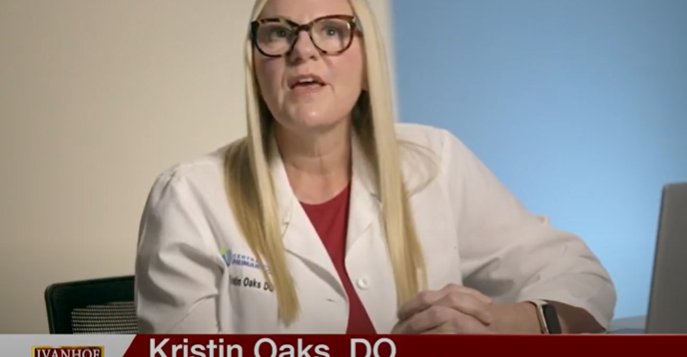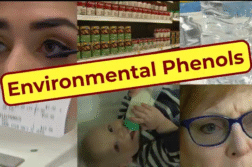Doctors Kristin Oaks, DO, a family physician at Central Ohio Primary Care, and Lou Civitarese, DO at Preferred Primary Care Physicians of Pittsburgh talk about a new technology program called Physician Insights that uses artificial intelligence to track a patient’s health outside of their exam room. Physicians Insights was created by agilon health, an organization that empowers physicians to transform healthcare in their communities.
Interview conducted in March 2022.
How is the program helpful for the patients and helpful for the practice?
DR OAKS: One of the most important uses of the tool is to find opportunities for improvement. I think as an innovative physician organization, we’re always trying to be the best for primary care, and that involves continually improving. So, this tool allows us to find outliers that have opportunity, and outliers that have really maximized their practice around that opportunity. Then, we can go find out what those physicians that are really doing great on inpatient hospitalization rates and ask what are you doing differently? We can extrapolate that to other practices. So, in that way, it’s really good for patients. Obviously, patients don’t want to be hospitalized. They want to be as healthy as possible. The tool allows us to look deeper in that way. The PCP Insights allows us to identify what opportunities exist for a particular physician. We can be targeted around two or three opportunities and give them ideas around those opportunities so that they can improve the care of their patients, and hopefully, the economics for their practice, as well.
DR CIVITARESE: As we have integrated more value-based care measures into our practice through our partnership with Agilon Health, this insight tool has provided a transparent view into how physicians are performing. The beauty of this platform is that it aggregates and synthesizes data from multiple sources across multiple points of care. It links up to electronic medical records and payer platforms to give us accurate and actionable data. And it goes beyond just the physician. We have a better understanding of whether each clinic in each pod is meeting quality standards, and we can look for areas of improvement across our entire practice. Our country’s health care landscape needs to transform to a value-based care model, which puts the physician in the driver’s seat of patient care. We look forward to leveraging our purpose-built technology engine to better understand the performance of physicians, improve the financial viability of physician practices, but most importantly achieve the best outcomes for our senior patients.
Is it too early to talk about the benefits of the program since it’s so new?
DR OAKS: Using PCP Insights, we can look for the opportunity in a physician’s panel. That opportunity is around wasted health care resources. So, obviously, we’re primary care physicians and our job is to take care of sick people. We’re not trying to look for the sickest or most expensive patients, that’s not what the tool does. Often waste hides in high-cost things, but that’s not the only place where you find waste. So really, the tool allows us to look for waste and then look at what is clinically modifiable by the physician. Over or underutilization of resources is waste. So, it really allows us to pinpoint what in our patient panel is being spent on care that does not either improve quantity or quality of life. That’s where we target our approach.
DR CIVITARESE: The complex care management program has benefited our practice at the patient-specific level. We’ve been able to identify our highest risk patients who typically are going to need the greatest attention, the greatest direction of our resources, and were able to associate them with a nurse who, in conjunction with the physician, helps manage that patient’s care in between office visits. And as a result, we’re able to identify problems just as they begin, as opposed to when they are much more intense, much more severe, resulting in, unfortunately, avoidable hospitalizations. So, our experience has been exceptional. Our patients very much appreciate the additional care that they get. They develop a personal relationship with their chronic care management nurse. And it really does develop into a synchronous team, and it allows us to have an additional caregiver in assisting in the management of these complex patients. So, it allows us to have more time in the office for our intensive visits, such as our annual wellness visit for our Medicare patients. So, the more time that we have in the office to spend with patients, the more thorough we can be in that once-a-year evaluation. And by having the chronic care management program, it really extends our ability to care for patients that are not in the office. So, the chronic care management nurses save us an incredible amount of time. They’re able to connect with patients independent of us. They’re able to then relay their findings, relay any concerns, give us updates. And we get these on a daily basis from our care management nurses, usually a couple to several a day, of course, typically on different patients. But by doing that, we can quickly respond to their questions. Every note that is sent to us from nurses is addressed that day. We answer their questions, we may make medication adjustments, we will order additional laboratory studies. And if we think it’s necessary, we’ll set up a virtual visit, which is also very helpful to the chronically ill patients who sometimes have a difficult time getting into the office. If we think we can manage the problem with a virtual visit, we’ll do that. And if necessary, we can then intervene and decide when that patient needs to come into the office. But simply by having an experienced RN who helps us remotely manage that patient, who gets to know the patient – they get to know the family, they get to know the caregivers, and so they really develop a personal relationship. And that relationship saves us a tremendous amount of time and allows us to be able to see additional patients in the office but know that we’re going to be very much in tune with going – what is going on in that patient’s home.
What are the different quality measures that you look at?
DR OAKS: Some of the different measures that I look at are how frequently a primary care physician is seeing their patients, what the rate of annual wellness visits is. One hundred percent would be perfect, but most of our doctors are over 90. We also look at rates of various cancer screenings or how quickly a patient is seen after an inpatient hospital stay. Other interesting things are how often does this physician see their patients as compared to the specialists? It’s really hard to have much control over a patient’s behavior if they see you once a year and they see specialists 15 times a year. I think, to improve the health of someone, you need a relationship, and a relationship takes time, right? In order to have a relationship with someone, you need to see them, and you need to be there for them when they’re really sick.
How you would approach a physician and what would you tell them about Physician Insights?
DR OAKS: The first thing that I do is look at the summary page on PCP Insights and look for the opportunities for that particular physician. Most physicians have a small number of opportunities and a lot of things that they’re doing well. I focus on what’s modifiable in that group of opportunities. Oftentimes, I have to meet with them because I can’t tell what’s modifiable. I need to know what happened with this person and why did they spend so long in the hospital? Generally, these primary care physicians have long-standing relationships. Sometimes, I can give them information about a patient’s conditions. Another thing is that post-discharge appointment. We know that seeing patients really quickly after they get out of the hospital is the most important thing that prevents rehospitalization, and it’s two days after discharge. It’s very difficult to meet that measure if you don’t know it’s importance. I think most doctors have never realized how quickly they see patients after their discharge. They have no idea what their rate is. Generally, people are interested in that. Most doctors will tell me they had no idea what percentage of their patients were seeing cardiology or what percentage of their patients went to orthopedists. Sometimes they can explain it and other times they’re confused. So, ideally, the first step is to understand where you are. I always say, you have to know where you are and have to figure out where you’re going before you can get on the path to get there.
Do you feel like Physician Insights is helping in any way?
DR OAKS: I think that the information is helping us to hone in on this idea that in value-based care, primary care physicians are meant to affect the cost of care and the care of our patients across all of the care they receive. Whereas, previously, it was just what we’re doing in our offices. I think this tool opens up the ability to affect all of the care that our patients are receiving.
Is it changing the landscape of health care delivery in this country? Or will it continue to if it’s being used?
DR OAKS: I think that the only hope to change health care delivery in the country is around tools like this. Primary care physicians need to be the quarterback of the team and they can’t be the quarterback of the team if they don’t have the data.
How has Agilon Health helped your practice?
DR CIVITARESE: Much of what we do within our partnership with Agilon Health are things that we’ve wanted to do for many years, but it’s simply not realistic that individual practices have the resources to develop the infrastructure, develop the technology to do what we’re doing. We have layers of trained professionals now, who assist us. We have technology benefits that we did not have in the past. If you’re not going to affiliate with a large partner that has the resources and brings intelligence and brings experience best of breed from what we’ve learned from other parts of the country – Agilon partners in different markets – it’s very difficult to keep up and it’s very difficult to be able to make the investments that are required to develop this team-based care. So, I would say, undoubtedly, this has been a great experience for us. And quite honestly, it may sound a little bit dramatic, but I think it really has been the solution to the survivability of independent medical practice. Without Agilon, without the resources that we can access, I just don’t know that we could have been viable and been able to keep up with all the changes and demands in health care as we went forward.
END OF INTERVIEW
This information is intended for additional research purposes only. It is not to be used as a prescription or advice from Ivanhoe Broadcast News, Inc. or any medical professional interviewed. Ivanhoe Broadcast News, Inc. assumes no responsibility for the depth or accuracy of physician statements. Procedures or medicines apply to different people and medical factors; always consult your physician on medical matters.
If you would like more information, please contact:
Lisa Stafford
lisa@staffordcommunicationsinc.com
Sign up for a free weekly e-mail on Medical Breakthroughs called First to Know by clicking here




